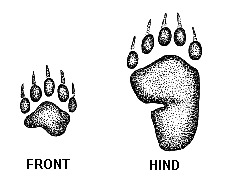
Striped Skunk
Mephitis mephitis
Description
- The size of this noxious odoured creature is similar
to that of a housecat. The strped skunk has a small, black
head with a white stripe between the eyes and two broad
white stripes which meet at the shoulders of its black
back. The tail is black with a white tip or fringe.
Distribution
- The striped skunk prefers the desert, woodlands, grassy
plains and suburbs. It occurs throughout the interior
and southern tier of Canadian provinces and all of America.
Biology
- The unique characteristic of the skunk is its ability
to spray a fetid, oily, yellowish musk 10-15 inches. This
fluid in the eyes causes intense pain and a fleeting loss
of vision. Ammonia or tomato juice are best to remove
the odour.
The
pelt is not highly valuable but the musk, once the odour
is removed, is used as a perfume base because of its clinging
quality. The skunk is an omnivore who feeds on a wide
variety of vegetable matter, insects and grubs, small
mammals, the eggs of ground nesting birds and amphibians.
In mid-May 4-7 young are born. Although they do not hibernate,
during the lean winter months they may become temporarily
dormant. The Striped Skunk is the main carrier of rabies
in the U.S.A. Its chief predator is the Great Horned Owl.
 Tracks - The skunk leaves a distinct pattern which
is easily identified. The smaller front feet are pigeon-toed
and placed just ahead of the larger rear feet while in
motion. This five-toed creature has long claws which are
usually evident in the print.
Tracks - The skunk leaves a distinct pattern which
is easily identified. The smaller front feet are pigeon-toed
and placed just ahead of the larger rear feet while in
motion. This five-toed creature has long claws which are
usually evident in the print.
Straddle: 7 - 10 cm (2.8 - 4 in)
Stride: 10 - 20 cm (4 - 8 in)
Track: Front - 3.5 cm (1.4 in) long / 3 cm (1.2 in) wide
Track: Rear - 5 cm (2 in) long / 3.5 cm (1.4 wide)
|


 Tracks - The skunk leaves a distinct pattern which
is easily identified. The smaller front feet are pigeon-toed
and placed just ahead of the larger rear feet while in
motion. This five-toed creature has long claws which are
usually evident in the print.
Tracks - The skunk leaves a distinct pattern which
is easily identified. The smaller front feet are pigeon-toed
and placed just ahead of the larger rear feet while in
motion. This five-toed creature has long claws which are
usually evident in the print.